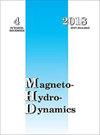先进钛合金冷坩埚熔炼技术的发展
IF 0.3
4区 工程技术
Q4 MECHANICS
引用次数: 0
摘要
冷坩埚用于在高温下熔化活性金属废料,以获得高质量的铸件或生产用于增材制造的球形粉末。最先进的坩埚有一个小的出口喷嘴,通过石墨或陶瓷材料保护的底部开口浇注熔融合金。喷嘴在高温下工作,通常持续几分钟,可能会给流出的液态金属增加污染。本文提出了改进该技术的新努力,目的是通过引入不同成分的液体助熔剂来净化液态金属并提高热效率,从而实现稳定的商业过程。避免污染的关键改进是采用一种新型的非消耗性喷嘴,该喷嘴由铜片和在喷嘴附近提供高频电磁场的第二线圈组成。喷嘴入口由与主熔体相同的合金的薄凝固层保护。交流电磁场增加了出口的加热,改变了速度场,提供了提取颗粒的可能性,并防止了渣带进最终铸件或生产的粉末中。电磁力允许控制流出速度,并增加出口金属的过热度。熔剂的存在使液态金属不与坩埚的水冷侧段直接接触。本文论证了数值模拟在预测和研究冷坩埚技术发展的各种选择方面的有效性。图8,参考文献13。本文章由计算机程序翻译,如有差异,请以英文原文为准。
Development of advanced cold crucible melting of titanium alloys
Cold crucible is used to melt reactive metal scrap at elevated temperatures for high quality castings or to produce spherical powders for additive manufacturing. The most advanced crucibles have a small exit nozzle to pour the molten alloy through the bottom opening protected by graphite or ceramic material. The nozzle operates at high temperature and typically lasts several minutes, possibly adding contamination to the outflowing liquid metal. This paper presents new efforts to improve the technique with the aim to achieve a stable commercial process by introducing melting of scrap metal in the presence of liquid flux of different compositions to purify the liquid metal and to enhance thermal effectiveness. The crucial modification in avoiding contamination is a new type of the non-consumable nozzle made of copper segments and the second coil to supply a high frequency electromagnetic field in the vicinity of the nozzle. The nozzle entrance is protected by a thin solidified layer of the same alloy as the main melt. The AC electromagnetic field adds heating at the outflow, modifies the velocity field, gives a possibility to extract particles, and precludes entrainment of slag into the final casting or into the produced powder. The electromagnetic force permits to control the outflow rate and to increase the superheat of the metal at the outlet. The presence of flux permits shielding of the liquid metal from direct contact with the water-cooled side segments of the crucible. The paper demonstrates the effectiveness of numerical modelling to predict and investigate a variety of options in advancement of the cold crucible technique. Figs 8, Refs 13.
求助全文
通过发布文献求助,成功后即可免费获取论文全文。
去求助
来源期刊

Magnetohydrodynamics
物理-力学
CiteScore
1.20
自引率
14.30%
发文量
37
审稿时长
6-12 weeks
期刊介绍:
Information not localized
 求助内容:
求助内容: 应助结果提醒方式:
应助结果提醒方式:


